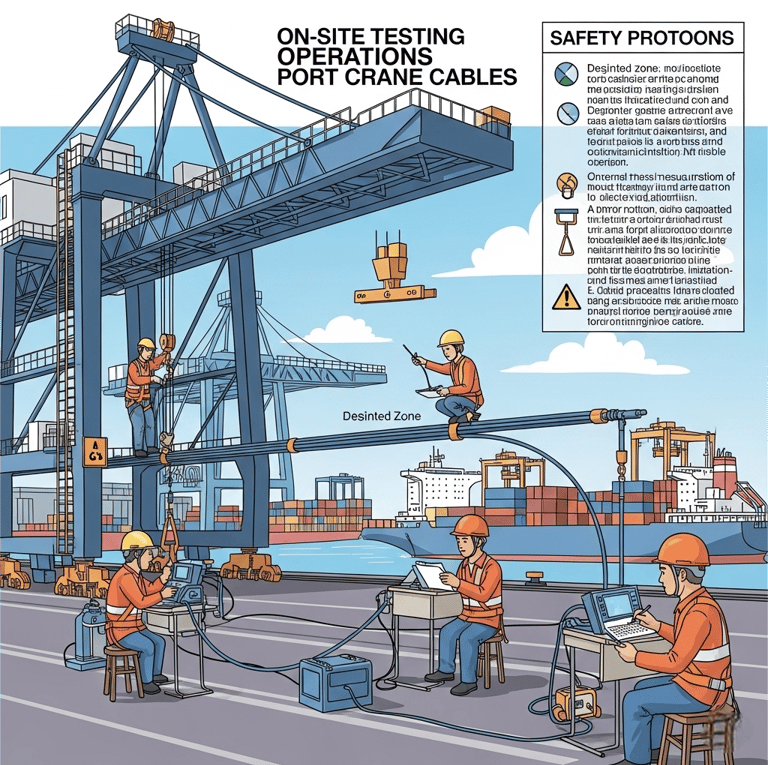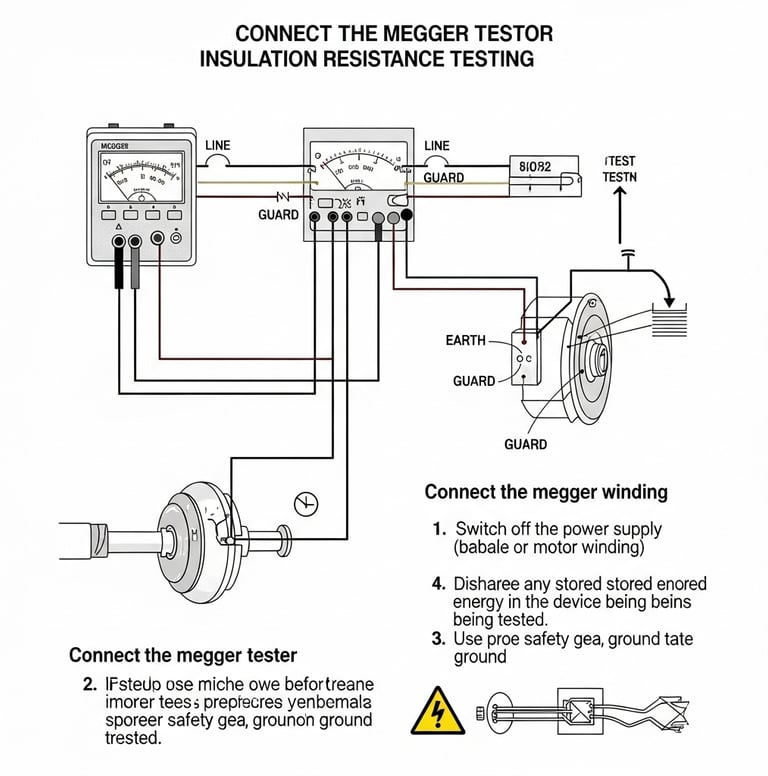📞+86 153 7530 2641 📧 hongjing.Wang@feichuncables.com
How to Perform On-Site Insulation Resistance Testing for Port Crane Power and Control Cables?
Learn how to properly perform on-site insulation resistance testing for port crane power and control cables to ensure safety and reliability. This comprehensive guide covers key procedures, tools, voltage levels, and compliance with IEC and AS/NZS standards. Ideal for port maintenance engineers and marine cable technicians.
hongjing.Wang@Feichun
7/18/20256 min read


What Is Insulation Resistance Testing?
Insulation resistance testing is a fundamental diagnostic procedure that measures the electrical resistance between conductors and between conductors and ground in electrical cables. The principle behind this testing method involves applying a DC voltage across the insulation material and measuring the resulting current flow. High resistance values indicate good insulation integrity, while low values suggest deterioration or damage.
For heavy-duty cable applications in port environments, insulation testing for marine cables serves multiple purposes. It helps identify moisture ingress, insulation degradation, mechanical damage, and thermal aging effects. The testing process provides quantitative data that enables maintenance teams to make informed decisions about cable replacement or repair schedules. High-voltage cable diagnostics through insulation resistance testing can detect problems that might not be visible through visual inspection alone, making it an essential tool for proactive maintenance strategies.
Why On-Site Testing Is Critical for Port Crane Operations
Port crane operations face unique challenges that make on-site testing particularly important. Environmental factors such as salt spray, high humidity, temperature fluctuations, and constant flexing during crane operations create conditions that accelerate cable degradation. Salt corrosion can penetrate cable jackets over time, while humidity can cause moisture ingress that compromises insulation integrity.
The dynamic nature of crane operations subjects cables to repeated flexing, twisting, and mechanical stress. This constant movement can cause micro-cracks in insulation materials, leading to gradual deterioration that may not be immediately apparent. Crane cable maintenance through regular testing helps identify these issues early, preventing unexpected failures that could result in significant downtime.
What potential problems arise if insulation is not properly maintained?
Poor insulation in port crane cables can lead to several serious problems:
Electrical faults and short circuits that can damage expensive crane control systems
Ground faults that may cause safety hazards and equipment shutdowns
Arc flash incidents that pose serious risks to personnel
Unscheduled downtime resulting in lost productivity and revenue
Cascading failures where one damaged cable affects connected systems
Increased maintenance costs due to emergency repairs and replacement parts
How does the marine environment specifically impact cable insulation?
The marine environment presents unique challenges for cable insulation:
Salt spray creates conductive paths that can cause tracking and flashover
UV radiation degrades polymer-based insulation materials
Temperature cycling causes expansion and contraction that can crack insulation
Moisture ingress through damaged jackets reduces insulation resistance
Mechanical stress from constant movement and vibration creates weak points


Best Practices and Maintenance Tips
Routine Inspection Intervals
Preventive maintenance for crane cables should follow risk-based scheduling:
Critical cables: Monthly testing
Standard power cables: Quarterly testing
Control cables: Semi-annual testing
Spare cables: Annual testing
Introduction
Port crane operations rely heavily on the integrity of electrical systems, making proper maintenance of port crane cables absolutely critical for safe and efficient operations. The harsh marine environment, combined with the demanding operational requirements of heavy-duty lifting equipment, places extraordinary stress on marine-grade cables. Regular electrical cable inspection through on-site insulation resistance testing serves as the first line of defense against potentially catastrophic failures that could result in equipment damage, operational downtime, or safety hazards.
The importance of on-site testing for port crane cables cannot be overstated. Unlike laboratory testing, field testing provides real-world assessment of cable conditions under actual operating environments. This approach allows maintenance teams to identify potential issues before they escalate into costly failures, ensuring continuous port operations and maintaining the safety of personnel and equipment.


Tools and Equipment Required
Proper insulation resistance testing requires specific equipment designed for marine applications. The primary tool is a megohmmeter, commonly known as an insulation resistance tester or "megger." These instruments apply controlled DC voltages while measuring the resulting current to calculate resistance values.
Megger testing cables in port applications typically requires instruments capable of applying test voltages of 500V, 1000V, or higher, depending on the cable's rated voltage. For low-voltage control cables, 500V testing is generally sufficient, while power cables may require 1000V or higher test voltages. Modern digital megohmmeters offer several advantages over analog models, including data logging capabilities, automatic discharge functions, and improved accuracy.
Essential equipment for insulation testers for port applications includes:
Digital megohmmeter with appropriate voltage ratings
Test leads with insulated probes
Grounding straps for safety
Personal protective equipment (PPE)
Cable identification tools
Documentation materials for recording results
Step-by-Step Guide to On-Site Insulation Resistance Testing
Safety Precautions Before Testing
Before beginning any testing procedure, safety must be the top priority. How to test cable insulation resistance safely requires following established protocols:
Verify power isolation - Ensure all power sources are disconnected and locked out
Confirm zero energy state - Use appropriate voltage detectors to verify no live circuits
Establish proper grounding - Connect equipment grounds and ensure personnel safety
Wear appropriate PPE - Including insulated gloves, safety glasses, and arc-rated clothing
Disconnecting and Isolating the Cable
Proper isolation is crucial for accurate testing and safety. Live cable testing procedures require that cables be completely disconnected from both power sources and loads. This includes:
Removing connections at motor terminals
Disconnecting control circuit connections
Isolating cable shields and armor
Ensuring no parallel paths exist that could affect readings
Testing Each Conductor-to-Ground and Conductor-to-Conductor
The testing process involves multiple measurements to comprehensively assess cable condition:
Conductor-to-Ground Testing:
Connect the positive test lead to each conductor individually
Connect the negative lead to the cable shield or armor
Apply test voltage for the specified duration (typically 1 minute)
Record resistance values for each conductor
Conductor-to-Conductor Testing:
Test between each pair of conductors
Ensure all other conductors are grounded during testing
Record all measurements systematically
Recording and Interpreting Results
Accurate documentation is essential for flexible cable insulation testing programs. Record all measurements with conductor identification, test voltages, environmental conditions, and any observations about cable condition. Digital megohmmeters often include data logging features that simplify this process.
Acceptable Insulation Resistance Values
Understanding what constitutes acceptable insulation resistance is crucial for proper cable assessment. Industry standards such as IEC 60502 and AS/NZS 5000 provide guidance on minimum resistance values for different cable types and voltage ratings.
General Guidelines for Insulation Resistance Standards:
Low voltage cables (up to 1000V): Minimum 1 MΩ per 1000V of test voltage
Medium voltage cables: Typically 5-10 MΩ minimum, depending on specific standards
Marine applications: Often require higher values due to environmental factors
What values indicate degradation?
Minimum resistance values for marine cables should be evaluated in context:
Trending analysis is more important than absolute values
50% reduction from baseline readings may indicate significant degradation
Values below 1 MΩ generally require immediate attention
Inconsistent readings between similar conductors suggest localized problems
Common Faults Detected by Insulation Testing
Insulation resistance testing can identify various types of cable degradation and damage:
Moisture Ingress
Water penetration through damaged cable jackets is one of the most common issues in marine environments. Moisture creates conductive paths that significantly reduce insulation resistance. Early detection through regular testing allows for preventive action before complete failure occurs.
Mechanical Damage
Physical damage from handling, installation, or operation can create weak points in insulation. Cable insulation breakdown often begins with minor mechanical damage that progressively worsens under operational stress.
Thermal Aging
Continuous exposure to elevated temperatures causes chemical changes in insulation materials, leading to gradual degradation. This process is accelerated in marine environments where temperature cycling is common.
Early Signs of Cable Failure
Crane cable failure prevention relies on recognizing early warning signs:
Gradual decrease in insulation resistance over time
Sudden drops in resistance values
Inconsistent readings between conductors
Temperature-dependent resistance variations
How to Record and Report Test Results
Proper documentation is essential for effective maintenance programs. Port crane maintenance logs should include:
Using Digital Loggers or Manual Sheets
Modern test equipment often includes built-in data logging capabilities that automatically record test results with timestamps and cable identification. For manual recording, standardized forms help ensure consistency and completeness.
Reporting Format for Marine Cable Maintenance
Insulation test documentation should include:
Cable identification and location
Test date and environmental conditions
Test voltage and duration
Resistance values for each conductor
Comparison with previous readings
Maintenance recommendations
Protecting Cables from Salt Corrosion and UV
Marine cable care requires proactive protection measures:
Regular cleaning to remove salt deposits
UV protection through appropriate cable jacketing or shielding
Proper cable routing to minimize mechanical stress
Environmental sealing at terminations and connections
How often should insulation resistance testing be performed?
Testing frequency depends on several factors:
Operating environment severity - harsh conditions require more frequent testing
Cable age and condition - older cables need more attention
Criticality of the application - essential systems require closer monitoring
Historical failure rates - past problems may indicate need for increased frequency
What environmental factors should be considered during testing?
Environmental conditions significantly impact test results:
Temperature affects insulation resistance readings
Humidity can influence surface leakage
Salt contamination creates conductive paths
Previous rain or moisture exposure may temporarily reduce readings
Conclusion
On-site insulation resistance testing represents a critical component of comprehensive port crane maintenance programs. The harsh marine environment, combined with the demanding operational requirements of port operations, makes regular testing essential for maintaining safety, reliability, and operational efficiency.
The investment in proper testing equipment and procedures pays dividends through reduced downtime, improved safety, and extended cable life. By following established testing protocols, maintaining detailed documentation, and implementing proactive maintenance strategies, port operators can ensure their crane systems remain operational and safe.
Regular insulation resistance testing should be viewed not as an optional maintenance activity, but as an essential practice that protects valuable assets and ensures the safety of personnel. The techniques and best practices outlined in this guide provide a foundation for developing effective cable maintenance programs that meet the unique challenges of port crane operations.
Encouraging routine testing for safety and compliance is ultimately about protecting people, equipment, and operations. As port operations continue to evolve and become more demanding, the importance of comprehensive cable maintenance will only continue to grow. By implementing these testing procedures and maintaining vigilant oversight of cable conditions, port operators can ensure reliable, safe operations for years to come.
How to Reach Us
Get in Touch
SiteMap
Product Catalogue
Reeling Cable
Festoon Cable
Shore Power Cable




Scan to add us on WeChat
